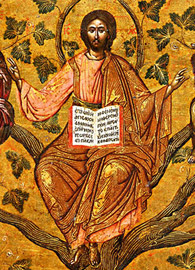John Week 8
Abiding in Love: Absently Present: John 15:1–17:26
Seattle Pacific University Assistant Professor of New Testament
Read this week’s Scripture: John 15:1–17:26
17:17
Key Prologue Terms: world, overcome/comprehend, children of God, Father/Son, revelation
Goodbyes and Graduations

 Enlarge
Enlarge
“Congratulations. You’ve reached this milestone in your life through hard work and dedication. Be thankful for those who have come before you, and for those who have encouraged you to reach for your dreams. Now go out into the world and make it a better place. Again, congratulations and best wishes!”
It doesn’t take a rocket scientist to know what advice is common in graduation speeches, whether pre-kindergarten or post-college (though the latter may add some advice about giving back to the alumni fund!). Graduation speeches are one way in which academic culture marks the transition between one level of learning and another, or a move out of the academic environment.
For college graduates these speeches also mark other changes. They often designate a transition to graduate school, back home, or job-hunting. For other graduates they point to a shift into full-time work without classes. Often they signal a major change in a family’s life as well as possibly requiring a move to another location. For these reasons graduation speeches have as much to do with saying goodbye as they do with maintaining one’s identity out there in the “real world.”
These chapters of the Gospel of John continue Jesus’ farewell speech — or perhaps his commencement address — to his disciples. The disciples are no longer just learners (the meaning of “disciple”), but they are also Jesus’ friends (literally “loved ones,” 15:13–15). Jesus’ speech marks a goodbye since he is leaving (death, resurrection, and ascension), but it also marks a transition for the disciples’ identity. Will they still be known by their association with Jesus when he is gone? What does their future entail?
Hanging Around (15:1–17)
The first part of this section of John describes Jesus’ relationship with God and the disciples’ relationship with Jesus through the use of another figure of speech (cf. 10:6). In his last “I AM” statement of the gospel, Jesus proclaims that he is “the true vine” and his “Father is the vinegrower” (15:1). Just like the figure of the shepherd in John 10, this imagery was very familiar to readers of Israel’s Scriptures. Israel is described as a vineyard that God planted and cared for in Isaiah 5:1–7 and Jeremiah 2:21.
In John 15, Jesus makes his relationship with God specific: he is “the true vine” (not a vine that will grow wild; cf. Jeremiah 2:21) cared for by God (15:1). This image demonstrates that God’s care does not change. Just as God was involved in clearing the land for the vine, planting a choice vine, and doing everything for its cultivation (Isaiah 5:1–4), so now God is involved with pruning the branches. Nevertheless, there is a difference here from how God’s vines are described in the Old Testament prophets. Most of the uses of this metaphor in the Old Testament describe the wild grapes yielded by the vine instead of the cultivated grapes that were expected. The vine in John 15 bears cultivated fruit, and has branches that are pruned in order to bear more fruit, while God removes those that bear no fruit (15:2). Wild fruit isn’t present here. Concluding the metaphor, Jesus says that the disciples are “cleansed by the word that” he speaks to them (15:3). This is another one of John’s wordplays: being “cleansed” and being “pruned” are the same Greek word. Jesus’ metaphor here echoes the episode where he washes the disciples’ feet. He washes their feet so that they can obey the commandment to love; in the metaphor of John 15, he prunes their branches so that they will bear more fruit.
The foot washing narrated in John 13 is an example of how love is sacrifice and service, exemplified in Jesus’ death. It answers the question “how should disciples act when Jesus is gone?” Here Jesus’ imagery of a vine with connected branches sustained by God’s care encourages the disciples to see that Jesus, the vine, won’t really have left, as the branches are still connected to him. The only way the disciples, i.e., the branches, will be able to bear fruit, is if they “abide” in Jesus (15:7). Disciples abide, or remain, in Jesus by keeping Jesus’ commandments. In John, disciples do this by loving one another as Jesus has loved them (15:12). Loving one another is remaining in Jesus, and is the fruit the vine bears (15:13–17). The disciples are encouraged to stay with Jesus — to love one another — but they are also encouraged by the fact that Jesus is hanging around (as the vine connected to branches) enabling them to love one another.
Going in Circles (15:18–16:4)
John has reached the pinnacle of an interesting quirk of his writing style. The gospel as a whole tends toward spiral writing, where the evangelist circles back to and further develops many of the same themes (e.g., light, life, love). This section of the gospel is particularly repetitive. [Author’s Note 1]
John’s spiral writing is not simply evident in repeating the same themes he has described previously. He also expresses definitions circularly: disciples abide by loving, and love by abiding. Or, in John’s terms, the “world hates” Jesus as well as the disciples (15:18), but “the world” in this gospel means those who are set against Jesus and the Father (15:23; cf. 1:10–11). John’s goal is not to frustrate his audience; instead he sees Jesus forcing people to a point of decision, whether they are with him (and therefore acting in love) or are against him (and therefore acting in hate). Because of the context of the gospel and the content of Jesus’ ministry, there is no middle ground.
Moreover, there are times in John when what is said in a certain context directly conflicts with what has been said before. For example, Jesus claims that none of the disciples ask him where he is going even though he has just told them that he is going “to him who sent me” (16:5), and Thomas said two chapters previously, “Lord, we do not know where you are going. How can we know the way?” (14:5). Indeed, Jesus has told them that they know the way to the place he is going, and that way is himself (14:4–6). [Author’s Note 2] It is important to note that the gospel seems unfazed by these conflicts between statements. The conflicts between statements like these often make readers of the gospel confused, curious, or fearful of misunderstanding. In this way the gospel puts its readers in the same position as the early disciples, needing to hear more explanations from Jesus.
Spiritual Things (16:4b–15)

 Enlarge
Enlarge
While John 15 reassures the disciples of Jesus’ continued presence, John 16 returns to the subject of Jesus’ absence. The solution to this apparent paradox of presence and absence is the Spirit, or in John’s terms, the Paraclete (see Lectio 7). The prologue of the Gospel of John has emphasized how significant it is that the Word that was with God and is God became flesh in Jesus (1:1, 14). Therefore this gospel must teach the disciples how to understand their continued role in the world when Jesus is no longer present in visible flesh. This theological claim is likely why this gospel spends more time describing the role of the Holy Spirit in the lives of disciples than Matthew, Mark, or Luke do.
In John 14, Jesus says that the Paraclete (Advocate, Comforter, Counselor, Healer) will come and be with the disciples forever (14:16). He is called “the Spirit of truth,” and only those who “abide” with him “know” him (14:17). In other words a relationship with the Spirit, just like a relationship with Jesus, requires continued presence as well as actions (“fruit,” 15:16) that reflect living in the Spirit’s presence. Furthermore, the Paraclete will perform two other functions: teaching the community “everything” and reminding the disciples of all that Jesus has said (14:26).
The gospel has referred to the second function of the Spirit before, as in 2:22: “After [Jesus] was raised from the dead, his disciples remembered that he had said this.” The remembrance of Jesus’ words and deeds is enabled by the power of the Spirit.
The third promise of the Paraclete is connected to these first two. The Advocate is responsible for testifying on Jesus’ behalf (15:26), as the disciples also are to do (15:27). Many others in the gospel are responsible for testifying to Jesus:
- John the Baptist (1:7, 8, 15, 32, 34; 3:26; 5:33)
- The community of Jesus’ followers/the crowd (3:11; 12:17)
- The Samaritan woman (4:39)
- Jesus himself, his words, and his works (3:32; 4:44; 5:36; 7:7; 8:14, 18; 10:25; 18:37)
- God the Father (5:32, 37)
- Israel’s Scriptures (5:39)
- The gospel itself as witness (19:35; 21:24)
In this way the Paraclete will continue the work of Jesus and others by enabling the community to testify about Jesus accurately as they learn and remember what Jesus has said and done (14:16–17).
Jesus continues to describe the work of the Paraclete once more as he bids his friends farewell. In John 16, Jesus claims that despite the disciples’ grief at his impending departure (16:20) there is an advantage: the Paraclete cannot come unless he leaves (16:7). The logic here is straightforward. According to John’s gospel, Jesus is the first Paraclete, the first Advocate and Counselor and Helper, and the Father will send “another” Paraclete when Jesus has left (14:16; 16:7). This second Paraclete is eternal and will never leave (14:16).
Furthermore, the Paraclete has one more additional function that is explained in John 16:8–10. This passage is the final time that the Paraclete is mentioned in the gospel (though see John 20:19–23). Here we find that the Paraclete’s task is not simply positive — namely, testifying to God’s work in Jesus and reminding the community of such work. Instead the Paraclete’s role is also to “prove the world wrong about sin and righteousness and judgment” (16:8). This task is also a continuation of what Jesus has been doing throughout the gospel.
Some clarifications are helpful here, as these words have unique definitions in the Gospel of John:
- the world = those who are opposed to Jesus (e.g., 16:11, 33)
- sin = not believing in Jesus; specifically, not believing that Jesus comes from the Father, does the will of the Father, and is the I AM (Yahweh), God of Israel (e.g., 8:24)
- judgment = what happens when people love darkness rather than light (e.g., 3:19)
Therefore, when the Paraclete proves the world wrong about sin, the Advocate is testifying that belief in Jesus is not sin, but rather the opposite is true (8:39–59). The world is wrong in its judgment: in opposing Jesus, it has shown that its true ruler is the devil (12:31; 14:30).
The last important point about the Paraclete in the Gospel of John is that the Paraclete comes to the community of Jesus’ followers. The focus is not on how the Spirit inspires the life of individuals. Instead the Spirit is a continuation of Jesus’ presence; the Spirit is Jesus who cannot be visibly seen by those who oppose him (14:21). The community experiences the Spirit in confirmation and remembrance of what God has done in Jesus and what God is doing in the community (14:12).
In-Between Time (16:16–33)
Using a theme from Psalm 30:5, where a night’s sorrow turns to morning joy, Jesus contrasts the disciples’ despair at his departure with the joy that they will experience at his return. This return implies both his resurrection and his final return (16:16–24). He describes the emotions present in this contrast using the motif of the feelings of a woman during labor and following her child’s birth. This metaphor was common in first century Judaism; in fact, Paul uses it to describe how creation is groaning for final redemption (Romans 8:22). Once “the day” has come, the anguish experienced in waiting will diminish or be forgotten (John 16:21).
The farewell discourse concludes with the narrator highlighting the disciples’ misunderstanding (16:16–19) and then, perhaps ironically, their claimed understanding (16:29–30). This is the first time that the disciples have spoken since the beginning of John 14, and it highlights their need for the Paraclete who will “guide [them] into all the truth” (16:13).
Jesus offers his followers peace now, as well as the confidence that he has overcome the world (16:33). This statement flies in the face of the events that are to come — the scattering of the disciples and Jesus’ glorification — and yet Jesus’ followers are to take heart, both in his situation and their own, that Jesus’ death and resurrection really has begun the process of restoring the world to rights.
An Overheard Prayer (17:1–26)
In Matthew, Mark, and Luke, Jesus prays for himself and his fate before his arrest (Matthew 26:36–44; Mark 14:32–39; Luke 22:39–44). In John’s gospel, however, Jesus prays for his followers as well. [Author’s Note 3] The focus of this prayer is on Jesus’ intercession, a role the Advocate or Counselor (Paraclete) will also undertake. This prayer summarizes John’s claims about Jesus’ relationship with God (17:1–5), and it echoes themes of John 14–16 (17:6–10). Jesus elaborates on his departure and prays that his Father will protect these followers (17:11–15). Just as we have seen in the previous chapters, Jesus emphasizes his continued connection with his loved ones as well as their disconnection from the world, defined as those who do not believe in Jesus (17:16–19).
Finally, Jesus’ prayer includes those who will believe on the basis of the disciples’ testimony, thereby looking toward the Church (17:20–26). The goal is that “the world may believe” that God has sent Jesus (17:21); in other words, that all people, “the world” that God loves (3:16) and that has denied God in Jesus, will come to see rightly.
Conclusion and “Graduation”
Jesus’ final goodbye to his disciples is directed to his Father rather than to the disciples themselves. In this way John shows how Jesus has a much larger community in mind than those disciples immediately around him. Jesus has instructed, commissioned, and prayed for his disciples. Now it is time to go out into the world — into the hands of those who oppose him. The stage is set for Jesus’ own “graduation,” but the honors awarded are a cross…and an empty tomb.
Questions for Further Reflection
- John’s gospel describes many different roles of the Holy Spirit. Which were familiar to you, and which were different? What accounts for the differences? Should some be more emphasized in your life?
- What practices in your life enable you to abide in Jesus? What do you wish you could do but aren’t doing now (and why aren’t you)? What kind of “fruit” are you bearing?
- Compare and contrast Jesus’ prayer in John 17:1–26 with the prayer he teaches his disciples to pray in Matthew 6:9–13/Luke 11:2–4. Based on what you now know about the Gospel of John, why do you think John presents Jesus’ prayer with similar themes but in this setting rather than the settings in Matthew and Luke?
<<Previous Lectio Back to John Next Lectio>>

This work is licensed under a Creative Commons License.




